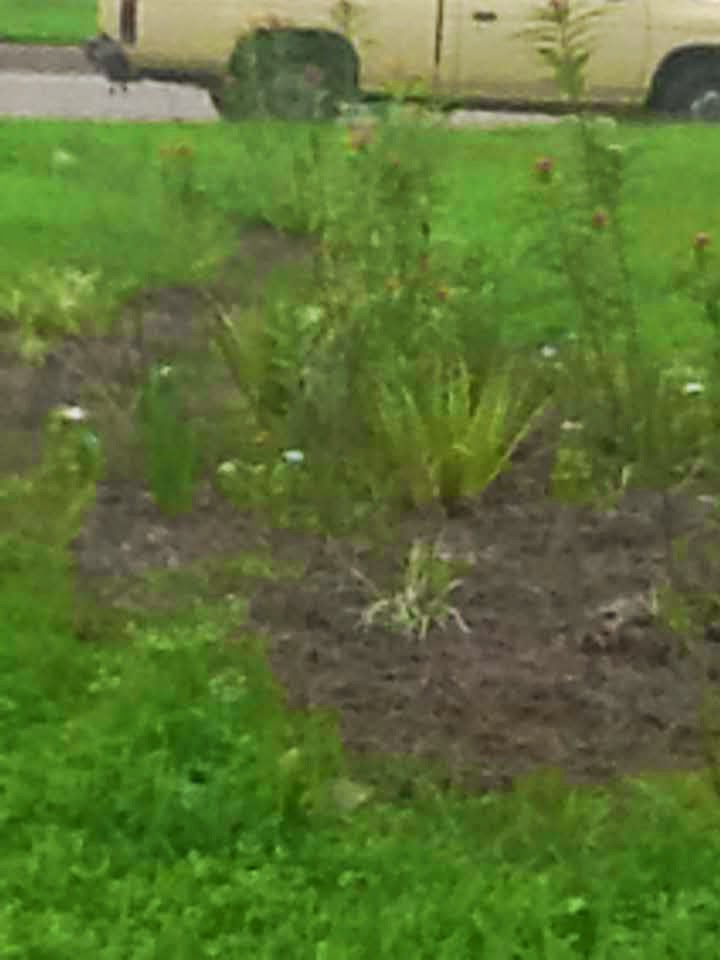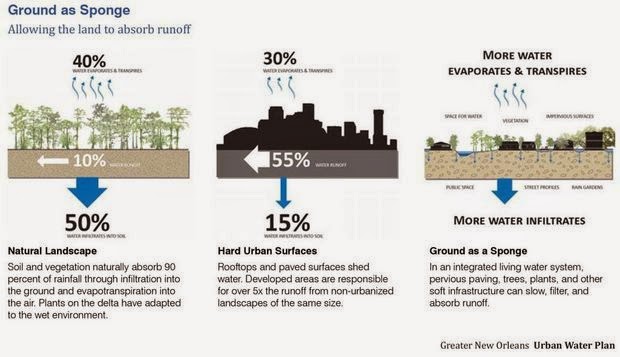Rain Gardens:
Why?
Reasons we can all relate to:
1) Street flooding.
(Image ) Rain gardens can help diminish street flooding by slowing the rate at
which water flows into city’s drainage system.
2) Diminish
subsidence. (Image) Subsidence occurs with water removal because a) organic matter in New Orleans’ spongy
soils oxidize and shrink when the water is removed, and
b) the
particles of that soil collapse onto one another when water is removed. (cite: http://www.guttertogulf.com/Why-is-New-Orleans-sinking/)Rain
gardens can help reverse subsidence by perking water back into the soil, one
garden at a time.
- An
article in Nature cited on NASA’s Earth Observatory website used satellite
imagery to determine that, in the three years before Katrina, most parts of the
city sank 8 mm. per year while some parts – those that received the worst
flooding – sank at annual rate of 28.8 mm per year. (http://earthobservatory.nasa.gov/IOTD/view.php?id=6623)
- Not
only do the buildings sink; the pipes sink and crack. This in turn creates more
drainage problems and more flooding.
3) Overburdened
drainage systems : cities with older drainage systems are in danger of
violating the clean water act because they have combined sewer systems, which
overflow in heavy rains and can send raw sewage into nearby bodies of water. The
EPA is encouraging older cities like New Orleans to develop multifaceted
approaches for slowing the rate at which rainwater is dumped into their
drainage infrastructure to keep us in compliance with the clean water act. Rain
gardens are part of this overall strategy to “think outside the pipe”. Important
in New Orleans – we average 64 inches of rain a year.
Other reasons:
4) They’re nice. (Image
of Magellan Street Garden)
5) Make use of a
resource (rainwater) that is otherwise wasted.
6) Chance to explore
native plants that tolerate flooding AND drought.
6) One part of the
garden you won’t have to pay a utility company to water.
What Is a Rain Garden?
Dr. Bill Schuster, EPA: “Basically a shallow bowl …. (that) accumulates
stormwater runoff” and acts as a sort of sponge.
-
Can be elaborate: e.g LSU Hammond’s rain garden
(photo), which drains a paved surface by means of an underground pipe and
collects water in a subsurface tank.
-
Can be raised, e.g. Tulane University’s Rain
Garden exhibit in New Orleans Botanical Garden (2 images). This has a solar-powered
pump that drives rainwater from a retention pond to planters y means of a
system of tubing.
-
Can also be very simple: (Image-Groundwork
NOLA’s vacant lot garden at N. Prieur and Caffin) A low-lying area excavated so
that it will capture significant rainwater, then planted appropriately.
Impervious paved surfaces and creating too much combined sewer system overflows. CSO’s
combine stormwater and sewage into same pipe. In heavy rains,. Sewage can
overflow untreated into nearby water bodies.
Older cities have these systems. Cities are being driven by
threat of running afoul of the U.S. Clean Water Act because they have too much
volume
Dr. Bill Schuster – any tool or technology we can use to
keep water out of the combined sewer system
Rain gardens one of those technologies
“rain gardens are a very simple and effective way of
infiltrating stormwater runoff … potentially soak up a lot of water and
function as a sort of sponge
Basically consists of a shallow bowl or patch within a
vacant lot … bowl accumulates stormwater runoff
What puts the garden in “rain garden” is that the community
plants species that are drought tolerant as well as can tolerate periods of
saturation




































